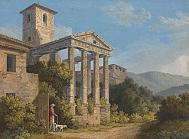 |
 |
 |
 |
Grades/Level: Middle School (6–8)
Subjects: Visual Arts
Time Required: 2–Part Lesson
One to two class periods
Author: J. Paul Getty Museum Education Staff
Permissions: 
The lesson plan and downloadable materials on this page are licensed under a Creative Commons Attribution 4.0 International License. |
 |
|
 |
 |
 |
 |
 |
 |
 |
Lesson Overview |
 |
Students will examine the use of the elements of art, including line, shape, form, texture, and color, in a drawing. They will also study the elements of architecture and learn to identify architectural elements in detail and their relationship to the surrounding landscape. Then students will draw an ancient Roman temple in perspective, integrating architectural elements in the drawing. |
 |
 |
 |
 |
 |
Learning Objectives |
 |
Students will be able to:
• recognize the elements of art and how they are used in a work of art.
• identify architectural elements in a work of art.
• describe how architectural elements relate to the landscape in the work of art.
• create a drawing in perspective, integrating architectural elements. |
 |
 |
 |
 |
 |
 |
 |
 |
 |
Materials |
 |
• Reproduction of The Temple of Hercules in Cori near Vellertri by Jakob Philip Hackert
• Background Information and Questions for Teaching about The Temple of Hercules in Cori near Vellertri
• Student Handout: "Elements of Art"
• Pencils
• Paper (8 1/2" x 11")
• Student Handout: "Identifying Architectural Elements"
• Teacher Resource: "Identifying Architectural Elements"
• Student Handout: "Architecture Vocabulary"
• Art Activity: "Draw an Early Roman Temple Using Two-Point Perspective"
• Paper (blue)
• Erasers
• Paint brushes (synthetic; optional)
• Watercolors (optional) |
 |
 |
 |
 |
 |
|
|
 |
 |
 |
 |
 |
Lesson Steps |
 |
1. Show students the reproduction of The Temple of Hercules in Cori near Vellertri by Jakob Philip Hackert.
2. Pass out copies of the "Elements of Art" handout from the Getty website.
3. Have a class discussion, prompting students with the questions from the Background Information and Questions for Teaching about The Temple of Hercules in Cori near Vellertri.
4. Pass out the paper and pencils to students, along with copies of the handout "Identifying Architectural Elements" to students.
5. As part of the discussion, have students identify and label the architectural elements in the "Identifying Architectural Elements" student handout. Refer to the companion Teacher Resource handout for correct labels. Students may refer to the "Architecture Vocabulary" handout.
Note: Words in bold on this page and/or handouts are defined in the "Elements of Art" or "Architecture Vocabulary" handout for this curriculum . (Also see the links listed in the "Art & Architecture Contents" menu above.)
6. Next, pass out copies of the art activity "Draw an Early Roman Temple Using Two-Point Perspective" to students, along with the blue paper, erasers, and paint brushes and watercolors (optional).
7. Discuss the opening paragraph on the art activity "Draw an Early Roman Temple Using Two-Point Perspective." Then tell students to follow the step-by-step instructions to complete this activity using the blue paper, pencils, erasers, and any other materials provided. You may want to model this activity for students before and/or during the activity.
|
 |
 |
 |
| The Temple of Hercules in Cori near Vellertri, Jakob Philip Hackert, 1783 |
 |
|
 |
 |
 |
 |
 |
 |
 |
Assessment |
 |
Students will be assessed on their
• recognition of the elements of art and how they are used in works of art.
• understanding of architectural elements of works of art.
• drawings in perspective, integrating architectural elements. |
 |
 |
 |
 |
 |
 |
 |
 |
 |
Standards Addressed |
 |
Common Core Standards for English Language Arts
Grades 6–8
SPEAKING AND LISTENING
Comprehension and Collaboration
1. Prepare for and participate effectively in a range of conversations and collaborations with diverse partners, building on others' ideas and expressing their own clearly and persuasively.
2. Integrate and evaluate information presented in diverse media and formats, including visually, quantitatively, and orally.
|
 |

|
 |
 |
 |




